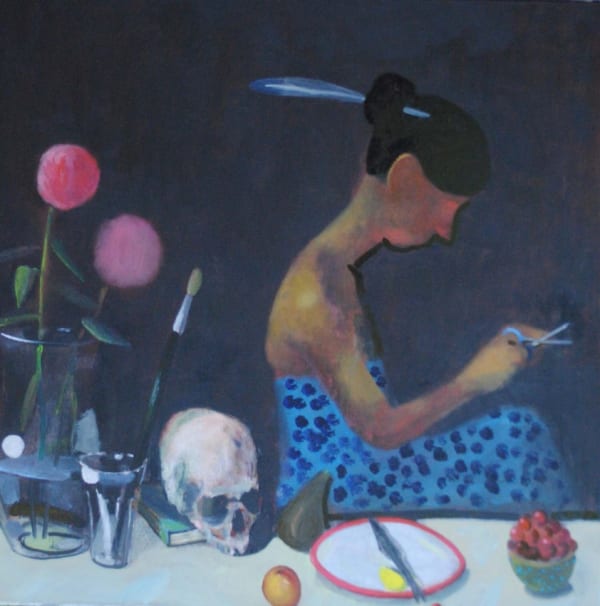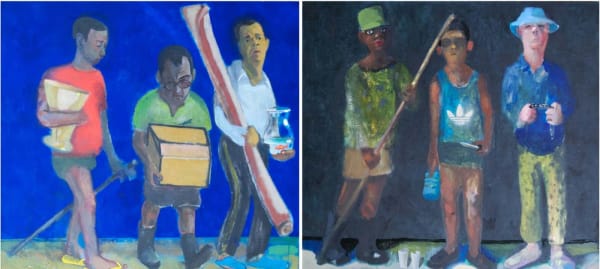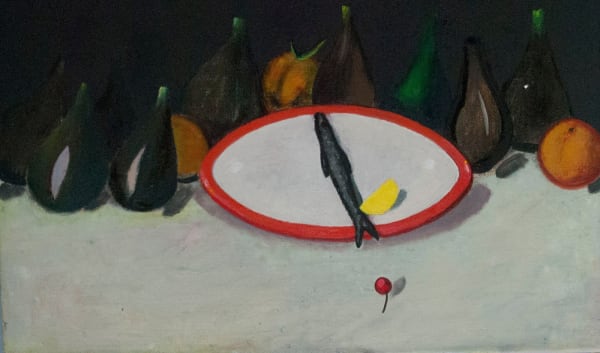Charles Williams' work is very like short stories. He tries to cram everything he is thinking about, other paintings old and new, newspaper stories, what he saw on his holidays or when he last went to the shops into each painting. We spoke to Charles who told us more about the story behind these stories . . .
"In common with many of my fellow New English members, I went to the RA Schools. It was a wonderful place and I met lots of people who remain friends to this day, both among staff and students. My most influential teachers were David Parfitt (who was Head of Painting then but became a New English member after I did), the late Roderic Barrett, and Mick Rooney. Another of my favourite teachers was Anthony Eyton, whose memory must be prodigious: although he is terrifically venerable, he still remembers me when we bump into each other. A few years ago I thought I recognised him in deepest, darkest Hackney and thought, ‘No, can’t be Anthony; he’s a South London man.’ After we passed, my wife Anna said, ‘Isn’t that that lecturer you talk to at private views?’ and I turned to see Anthony standing on the curb, waving to me.
Dustman, cab driver, teacher . . .
I had a lot of romantic and unfeasible ideas about what I wanted to do until I was about twenty, by which time parental objections had been replaced by desperation, ‘Please find something to do! Anything! Just leave us alone!’ and I managed to get into Art College. That solved the problem of what I wanted to be, but not of how to get money. I was a dustman one summer, and then a cab driver for a while, to subsidise my painting, and now I teach (I'm Programme Director of the degree in Fine Art at Canterbury Christ Church University). I love teaching, because it is such a challenge to keep up with young minds.
Admired artists
The pantheon of admired artists changes every time I see a new exhibition or read another book. It’s terrible. I went to the RA’s 'Abstract Expressionist' exhibition in 2016, thinking ‘this is going to be amazing’ but actually, even though there were paintings there that I have loved and thought about for twenty years and more, I remained oddly unmoved. And then a couple of years ago, I went to a show of an artist called Merlin James at Parasol unit in City Road. I have puzzled over his very peculiar work for years, and was absolutely knocked out by it. I felt thrilled and horribly jealous at the same time, and still fascinated to know what was going on behind the work - what it was about, how he got to that point. As I was leaving, exhausted, exhilarated, angry, I saw the catalogue and I opened a copy and started to read. There was an explanation of one of the paintings, and I suddenly panicked: I didn’t want to know! Don’t explain it! I shut the book hurriedly and rushed out. Contemporary artists I admire include Phoebe Unwin, Emma Talbot and Tomma Abts.

'The Russian Protester'
The piece that is my favourite is the one I have just finished. When I finish another one, that one becomes my favourite. Here’s the story behind ‘The Russian Protestor’ (which must have been my favourite for a short while).
He was a gay rights protester, who featured in a rather lowbrow-sounding TV documentary series called 'Reggie Yates’ Extreme Russia'. Reggie Yates is a youth TV presenter, or DJ, or something, but the series was actually pretty good. He's a charming sort of fellow, not amusing like Louis Theroux, but nice, and he talks bravely to all sorts of dreadful Russian types: nationalists, homophobes, gangsters, racists. One of the programmes was about the absurd Russian anti-homosexuality laws, and this young man was a high profile protester, arrested and beaten up countless times, all of them legal.
Mentioning homosexuality in public, or promoting it, is illegal in Russia and I think that the laws had been altered so that any group numbering more than one could be seen as an illegal meeting. So his protest was to stand on his own, with a sheet of paper with nothing written on it. He was well-known for his views, and everybody knew what he was talking about, but he was saying nothing at all in explicit terms. He was waiting to be arrested illegally.
He was a very odd young man. He was slight and pale and red-haired, and he seemed determined to be martyred. He had a new tattoo on his forehead; l could never work out what it was. Reggie joined him on his protest, but soon enough he became frightened and they had to call it off. Protest is serious in Russia.
The image appealed to me. The horror of his martyred state and the intensity of his path touched me, as well as his sense of aloneness. A person outside his culture.
I started with what I would describe as a drawing. When I was in my studio, I remembered the scene in the TV programme the night before, and l tried to remember it on paper, drawing it out of my mind in watercolour and gouache, about 30cm high. Next I painted the image larger, this time relying as much on the drawing as my memory, and it may be significant that I was using a paint type that I had not used before, a kind of gouache that I had ground and prepared myself.
This led to my exploring the relationships between the colours and the surfaces that the paint made, setting up a new mesh of visual interest. What was the relationship between that focus and the figure itself? Did it obscure the message with the medium, or did my concentrating on the medium allow the message to come clear, independent of my conscious control?
The subsequent paintings were painted with less and less direct reference to the memory of the TV programme and more reference to the paintings themselves, which implies a certain formal interest, a growing interest in the methodology and technique as against the content. I am looking for what would make the painting good, and when I find it I stop.
‘You’re lucky to sell anything at all!’
The first painting I sold was at the RA Summer Exhibition, when I was a student. It was a life painting, of a young woman who posed for us for a term, while she was heavily pregnant. She was a strange creature, and I think I was a little in love with her. By the end of the term no one else but us was in the life room. I don’t think she felt the same way about me, though. The painting was very blue. It was bought by someone who didn’t really seem to want it, at least that’s how it felt when I called them to arrange payment and picking it up. I kept getting the wife of the man whose name was on the card, and she kept saying, ‘He’s not here; ring back in a few days’ and when I did she said, ‘Stop bothering me. You’re lucky to sell anything at all!’ I did get a cheque, eventually, but the guys in the vault where the sold work is stored told me he didn’t pick it up for months.
Routine and the role of the viewer
Routine is something to cling on to if you are afraid you are not really an artist. I could not care less about it. Nor do I care much about my studio. I just like painting. But at the moment, I am teaching more than I am painting, and I don’t need to sell my work to live, so perhaps I have a different idea about it to a lot of the other New English members.
I think about the viewer all the time, and my feeling vacillates between not caring a damn and being desperate for validation. Social media allows you to put images of your work on public exhibition as you create it, and I am not sure I think that’s a great thing. I must stop doing it . . .
Aunties and Uncles at the New English Boxing Ring
I became a member of the New English Art Club in 1996, I think . . . or 1997. It was lovely, because I wasn’t in teaching, and I didn’t live in London, and I needed some kind of network of fellow artists. I was a bit younger than the majority of the membership, so joining was like being given a whole load of aunts and uncles, who seemed interested and pleased to see me. I am rather pathetically grateful for any evidence of friendship, I’m afraid. I got very involved for quite a while, sitting on the committee and performing several roles within the Club. I was at Ken Howard’s studio when we dined Prince Charles (I have a couple of scurrilous anecdotes about that, but they are a bit nasty and possibly treasonous) and part of the committee when we decided to finance Kenneth McConkey’s excellent book ‘The New English’ and I was Curator of the Drawing School for some years. But as my other teaching has expanded I have had less time, so I have backed out of the boxing ring that is the New English. I haven’t thrown in the towel though . . .
I have plenty more anecdotes I could share, but most of them, as I said, are scandalous and sometimes a bit nasty. I have published a little book called ‘Talking To Louise Bourgeois’ which includes some of them."
Find out more about Charles on his artist profile page, where you will also find a selection of original artwork for sale.
His work will feature in the New English Art Club Open Exhibition at Mall Galleries in London, 16-25 June 2017.







